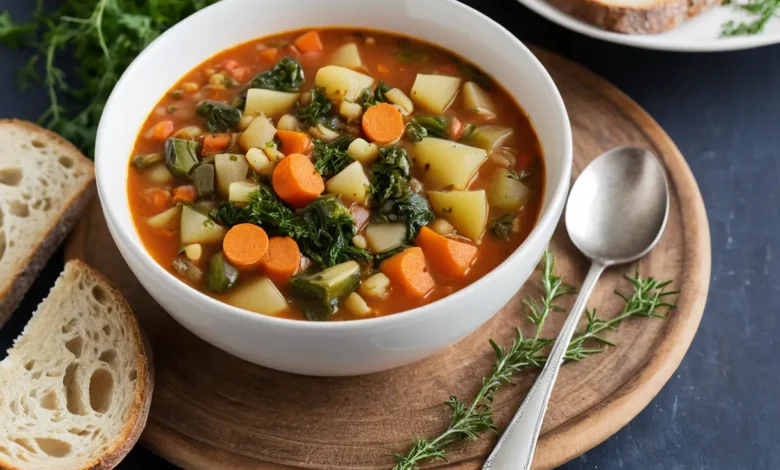The Ultimate Hearty Vegetable Soup Recipe: A Healthy and Delicious Comfort Meal

There’s nothing more comforting than a bowl of hot, homemade vegetable soup. Packed with nutrients, low in calories, and bursting with flavor, vegetable soup is the perfect dish for anyone seeking a healthy yet satisfying meal. Whether you’re looking to warm up on a chilly day or want a light and refreshing meal, this vegetable soup recipe will hit the spot.
This recipe is easy to customize with your favorite vegetables, and it’s a fantastic way to use up leftovers. In this post, we’ll walk you through the steps to make the ultimate vegetable soup, answer common questions, and share tips to help you elevate your soup to the next level.
How to Make Hearty Vegetable Soup: Step-by-Step Recipe
Ingredients
- 2 tbsp olive oil
- 1 large onion (chopped)
- 2 garlic cloves (minced)
- 3 carrots (peeled and sliced)
- 3 celery stalks (chopped)
- 2 potatoes (peeled and diced)
- 1 zucchini (chopped)
- 1 cup green beans (trimmed and cut into bite-sized pieces)
- 1 can (14.5 oz) diced tomatoes
- 6 cups vegetable broth (low sodium preferred)
- 1 cup frozen peas or corn
- 1 tsp dried thyme
- 1 tsp dried oregano
- 2 bay leaves
- Salt and pepper to taste
- Fresh parsley for garnish (optional)
Instructions
Step 1: Sauté the Vegetables
Start by heating olive oil in a large pot over medium heat. Add the chopped onions, garlic, carrots, and celery. Sauté for about 5-7 minutes until the vegetables soften and the onions become translucent.
Step 2: Add the Remaining Vegetables
Once the onions and garlic are fragrant, add the diced potatoes, zucchini, and green beans to the pot. Stir well to combine. Cook for another 5 minutes, allowing the vegetables to start softening.
Step 3: Pour in the Broth and Tomatoes
Next, pour in the vegetable broth and canned diced tomatoes (including the juice). Add the thyme, oregano, bay leaves, salt, and pepper. Stir everything together, then bring the mixture to a boil.
Step 4: Simmer the Soup
Once the soup reaches a boil, reduce the heat to low, cover the pot with a lid, and let it simmer for 25-30 minutes. Stir occasionally to prevent the vegetables from sticking to the bottom.
Step 5: Add Peas or Corn
During the last 5 minutes of cooking, stir in the frozen peas or corn. These vegetables cook quickly and add a touch of sweetness to balance the savory broth.
Step 6: Adjust Seasoning and Serve
Taste the soup and adjust the seasoning if necessary. Remove the bay leaves before serving. If you like, garnish with fresh parsley for added color and flavor. Serve hot and enjoy!
Frequently Asked Questions (FAQs)
1. Can I make vegetable soup in a slow cooker?
Yes, vegetable soup can easily be made in a slow cooker. To do this, simply sauté the onions, garlic, carrots, and celery on the stovetop, then transfer everything to the slow cooker. Add the rest of the vegetables, broth, and seasonings. Cook on low for 6-8 hours or on high for 3-4 hours until the vegetables are tender.
2. Can I freeze vegetable soup?
Absolutely! Vegetable soup freezes very well. Let the soup cool completely before transferring it to airtight containers or freezer-safe bags. Label the containers with the date, and freeze for up to 3 months. When you’re ready to eat, thaw the soup in the refrigerator overnight and reheat on the stovetop.
3. What are the best vegetables to use in vegetable soup?
The beauty of vegetable soup is its flexibility. While this recipe calls for carrots, potatoes, zucchini, and green beans, you can easily swap in your favorite vegetables. Popular additions include spinach, kale, sweet potatoes, bell peppers, and butternut squash. Just be mindful of the cooking times, as some vegetables cook faster than others.
4. How do I make my vegetable soup more flavorful?
To enhance the flavor of your vegetable soup, be sure to use fresh, high-quality vegetables and herbs. Sautéing the vegetables before simmering helps develop their natural sweetness. Adding a splash of lemon juice, balsamic vinegar, or a dash of hot sauce at the end of cooking can also brighten the flavors. You can even throw in a Parmesan rind while simmering for a deeper, savory taste.
5. Can I make vegetable soup without tomatoes?
If you prefer to make vegetable soup without tomatoes, simply omit the canned diced tomatoes from the recipe. You can replace them with an extra cup of broth or water to maintain the soup’s volume. The result will be a lighter, less tangy soup, but still delicious.
6. What’s the best way to store leftover vegetable soup?
Store leftover vegetable soup in an airtight container in the refrigerator for up to 4 days. The flavors will continue to develop, making the soup even tastier the next day. Reheat the soup on the stovetop or in the microwave when ready to serve.
Pro Tips for a Flavorful Vegetable Soup
- Use Homemade Broth: If possible, make your own vegetable broth for added depth of flavor. You can use leftover vegetable scraps, such as onion peels, carrot tops, and celery leaves, to make a nutrient-packed broth.
- Add Grains for Extra Heft: For a heartier soup, consider adding cooked quinoa, barley, or rice. These grains soak up the flavorful broth and make the soup even more filling.
- Blend for a Creamy Texture: If you prefer a creamier vegetable soup, you can blend a portion of the soup with an immersion blender or in a regular blender. This will thicken the broth and give it a velvety texture.
- Don’t Overcook the Vegetables: While you want the vegetables to be tender, overcooking them can cause them to lose their texture and flavor. Be sure to keep an eye on the cooking time, especially when adding delicate vegetables like spinach or peas.
Conclusion
Vegetable soup is a delicious and versatile dish that is both nutritious and satisfying. With this easy recipe, you can whip up a hearty pot of vegetable soup using ingredients you likely already have on hand. Whether you enjoy it as a light lunch or pair it with some crusty bread for a more filling dinner, this vegetable soup will quickly become a favorite in your household.
Remember, this recipe is highly customizable—feel free to add or swap vegetables to suit your tastes. And with a few simple tips, you can ensure your soup is flavorful and nourishing every time.





